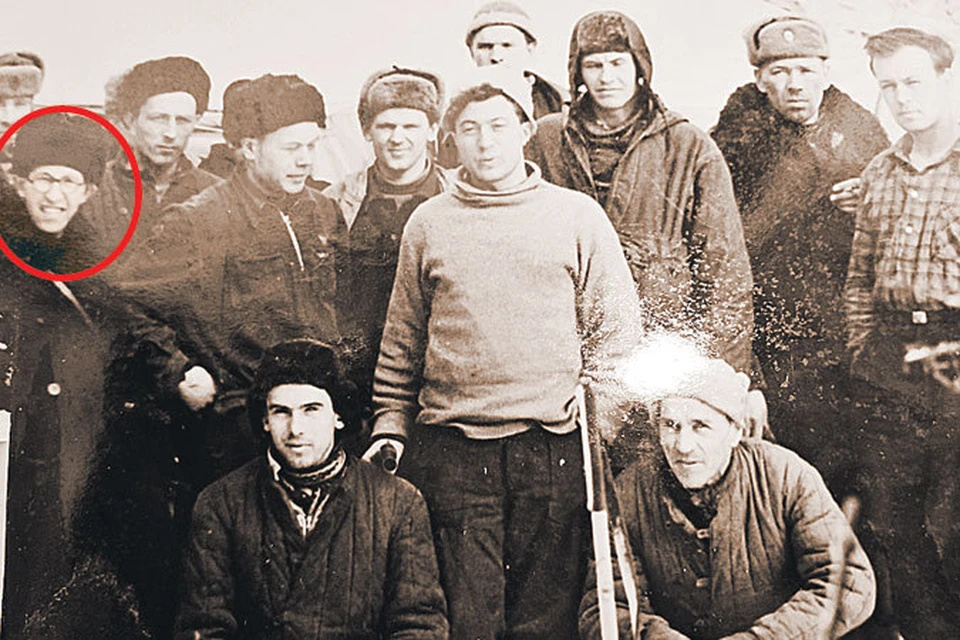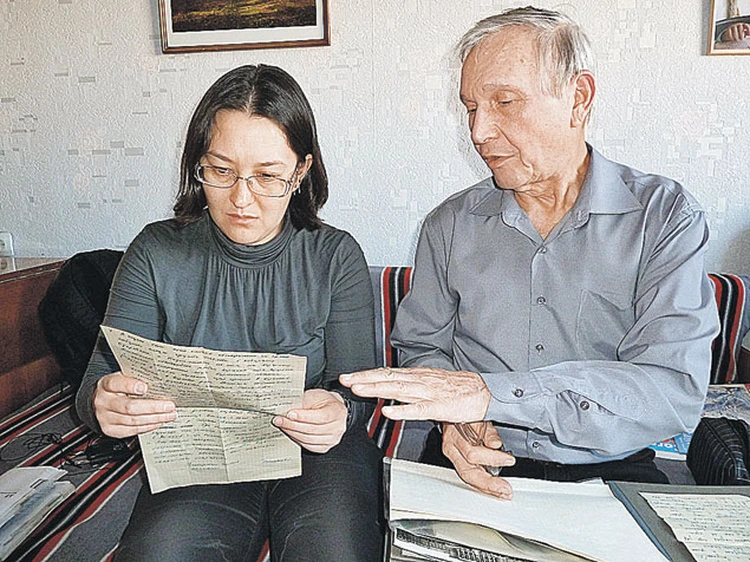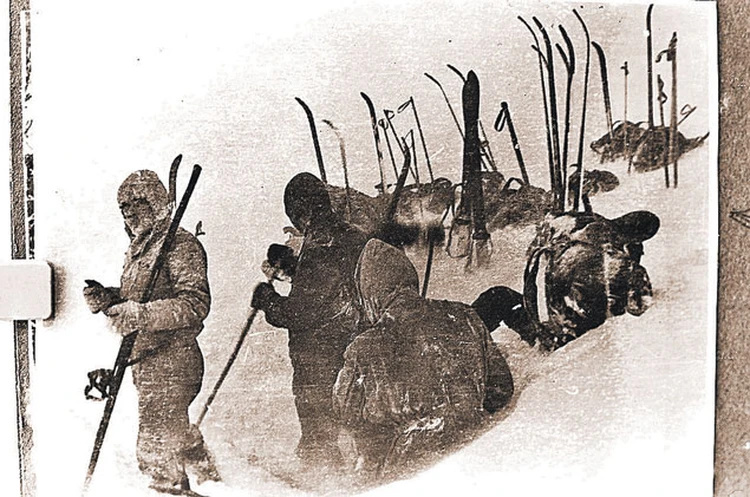
Dyatlov group could have taken doping
is the opinion of Vadim Brusnitsyn, who in 1959 was a student at the Ural Polytechnic Institute and was among the first to arrive at the scene of the tragedy.
February 16, 2014. All rights belong to Komsomolskaya Pravda. Authors Nikolay Varsegov and Natalya Varsegova

Early March 1959. The first searchers have landed on the Dyatlov Pass. Among them is the criminal prosecutor Lev Ivanov. This photo once again confirms that Lev Nikitich has been involved in the investigation from the very beginning of the search for the missing group.
– Our group was landed from a helicopter on the eastern spur of Otorten. We decided to look for the missing hikers in the valley of the Vishera and Auspiya rivers. We headed straight south. And there in the evening we stumbled upon ski tracks. In some places they were covered, but in some places they are clearly visible.
– Did you immediately realize that these were left by the Dyatlov group?
– We knew that hunters rarely reached these places and, except for the Dyatlov group, there should not be anyone here. Soon we found a camp site of the Dyatlov group in the forest. There was nothing strange about it. The usual bivouac. We went along the ski trail we discovered, but it soon got lost. The next day we split into several groups. Slobtsov and Sharavin went to the pass and found the tent. On the same day, a canister was dropped from the plane, in which Colonel Ortyukov, the head of rescue operations, gave valuable instructions on the search. But it was too late for them. A little later, a dog sled with Mansi people and a walkie-talkie arrived. We sent a radiogram to Ivdel that the tent had been found.
– And when did you personally see the tent?
– In the first days I was not at the tent. We were preparing a camp and leveling a landing site for the helicopters. After that, I climbed the pass alone. I looked into the tent. Things were not scattered, everything was inside. But the wind brought a lot of snow into the tent. My attention was drawn to the footprints that led away from the tent. They were poles packed with snow. They were viewed at a distance of 5 - 10 meters. I got the impression that people jumped out of the tent and immediately rushed to the run. It was noticeable in the length of the step. One and a half meters! I examined these columns for a long time and singled out only one trace, which clearly belonged to one person. And the rest were - one to the right, the other to the left. Then the tracks broke off on a hard crust. And I went through the entire route of the Dyatlov group all the way to the cedar.
– When you went down the slope were the the bodies from under the cedar have already been taken?
– No, they were still untouched, a little powdered with snow. They lay just like in famous photographs - side by side.
– And were there any tracks under the cedar, except for fresh ones from the searchers?
– No. There was a crust on which no traces remain. There were such strong winds. Cedar then stood almost at the edge of the forest. The winds were strong.
- 2 -

Vadim Brusnitsyn shows correspondent Natalya Ko the notes that the leaders of the rescue expedition dropped off the plane for the searchers.
Bright spheres over the Urals
– What thoughts did you and your colleagues have at that time about the causes of the tragedy??
– We discussed that it could be a bright light, or a sound. We also talked about the glowing spheres that then flew over the Urals, that they could scare the guys. But these balls flew silently. I've seen it myself, no big deal. I was told later that it was the air defense service that fired balloons glowing with a greenish light over the Urals, and then shot them down. They were launched into the wind at different heights.
– Couldn't it have turned out that the balls flew over the tent and were hit by a rocket?
– I don't think so.
The mystery pole
– Tell us how you dismantled the tent.
– The head of the search operation Maslennikov instructed me to take care of the tent. He ordered all things to be written down. First, we cleaned the tent from snow, took everything out carefully. The outer clothing of the hikers was crumpled and frozen. And in the northern end of the tent, we found something strange - a ski pole cut into several pieces lay on top of the clothes. Then we realized that the northern skate had fallen, because someone took off the pole that was propping it and began to cut it. I even remember the shavings from cutting. She lay right there.
– Was the stick bamboo?
– I don't remember exactly, but I think it's birch. Bamboo sticks were in short supply at the time. In that group, in my opinion, only Dyatlov had bamboo sticks. They just haven't been delivered to us since pre-war times.
– How was the stick cut?
– Perpendicular to the axis. Right around the circle. And then they broke it in the cut.
– Do you remember the stove?
– Certainly. Inside there was dry firewood. But this stick puzzled me then. And not only me. We all wondered why it was cut. After all, this action was extremely unreasonable. It turns out, figuratively speaking, the Dyatlov group cut the branch on which they were sitting, thereby dropping one edge of the tent... And then I received an order, it seems, from investigator Ivanov, to roll all things into a tent and load it into a helicopter. This is where the stick went.
– You were at the wake of Yuri Krivonischenko. What did his parents ask you?
– Nothing. We sat on the floor in an almost empty room and discussed everything we saw on the pass. There were about 12 of us. I did not see Yuri's father, and his mother only brought us food and did not ask any questions.
– Maybe the high-ranking parents of Krivonischenko already knew the truth, and therefore they didn’t ask questions? In the criminal case, there is an interrogation of Aleksey Krivonischenko, the father of the deceased Yuri. And there he reports that they had students at their son's wake, who on the night of the tragedy were also on a trek near Otorten. And these students said they saw flashes over the place of the tragedy.
– It is possible that they had some other group at the wake, but in ours no one said anything like that. No flashes could scare the Dyatlov group. I myself witnessed something like that through the tent, looked out, and that's it.
- 3 -

The last photo of the Dyatlov group. Hikers put up a tent for the last time in their lives. The pass is cold and windy.
The magic pills
– What do you think happened there?
– I went through all versions. In my mind I sat down in their tent and asked myself - what would you do if this or that happened? And none of the versions could have kicked me out into the cold with no clothes and shoes.
– But if we assume that there were firings of an S-75 anti-aircraft missile at these luminous balls. Somewhere nearby fell a rocket with heptyl fuel. And people began to suffocate from the vapors of heptyl?
– Then there would be some traces. But neither I nor my colleagues saw anything like that. All the snow at the tent and at a distance from it was blown away. We would have found any iron.
– There is an opinion that the military could have removed the missile before you arrived.
– Then they couldn't have covered their tracks so carefully. We would notice the presence of strangers.
– And what about the fact that the Slobtsov found a working flashlight on top of the tent? If the flashlight was left by the Dyatlov group, how did it lie in the cold for 25 days and the battery did not run out?!
– So it was a good battery.
– And with such strong winds on the pass, could the tent stand for a whole month?
– Certainly. It was very well installed. By all the rules.
– What did you end up with?
– At that time in the USSR, work was already underway on the production of psychotropic drugs. And this could be indirectly learned from the newspapers. For example, our athletes won a lot of gold medals at the Melbourne Olympics. And there were suspicions that athletes could have used "magic" pills.
– And Dyatlov could have got his hands on such drugs?
– There must have been something on them. And, perhaps, the drug was affecting people under less stress one way. And with heavy loads in field conditions, the drug could have a different effect. In addition, their strength was already exhausted and their nerves were on edge. They were behind schedule.
Why was the Regional Committee alarmed?
– Could the drug cause insanity?
– It could have affect on the consciousness of the entire group. And everyone behaved inappropriately. This explains the serious injuries on them. At first I went from the tent to the cedar, carefully examining everything. And the next move I made on the run. But, true, in shoes and dressed. And I realized that it's hard to stop when you run across the crust. Lots of obstacles on the way. And if I run at night, I wouldn't see these obstacles. Instead of shoes, I would have socks that do not hold in the snow. This means that a person whose consciousness is clouded falls. Fell on the rib, broken rib. He fell headlong on a rock and cracked his skull.
– And where did the guys get doping from?
– I can guess who got the dope and through whom, but I won't say it without having exact information. I think the law was violated on this part. No wonder the Regional Committee leaders were so alarmed. Apparently, so that no one would know how this drug got to the hikers.
– But after all, it is logical to take doping not at night, but in the morning - just before the ascent?
– True. But they might not have known it the first time they tried it. I had such an experience. Somehow, before climbing the Tien Shan, I decided to try how will the golden root affect my strength. The night before the ascent I tried this root before going to bed. There was no sleep at all, only hallucinations. And the next day I was all broken.
– Have you experienced a cold overnight stay in winter?
– Many times!
– Then a question. After a hard day and in a cold tent, could the guys draw the famous wall newspaper "Evening Otorten" with their frozen hands?
– Perhaps the newspaper was drawn earlier. The date is February 1st. And some funny stuff. From the photos you can see that it was very cold - wind and snow. I think that they climbed into the tent with pleasure, but not in order to draw a newspaper, but to rest, to sleep.
– But if you take some kind of doping, then you can also deal with a wall newspaper instead of resting?
– Could be. But it seems to me that it was some very strong drug, from which they all simultaneously lost their minds.
- 4 -
From the authors
We do not claim that the doping version can be true. But there is no reason to deny it either. It is known that in those days, various kinds of doping were indeed used among athletes. Their perniciousness has not yet been very well studied. In the West, for example, the drug LSD was used as a stimulant. Here is what the scientific literature says about LSD: "The effects of LSD are felt 30 to 90 minutes after ingestion. The pupils often dilate. Body temperature either rises or falls. Large doses of LSD cause hallucinations. These feelings can cause panic. A person under LSD can go out of the window to "take a closer look" at the earth... "
Similar drugs were invented in the USSR. It can be assumed that one of the hikers got stimulants. Or even someone in the group was instructed to try out a new dope in field conditions. Eight hikers out of nine may not have known that along with evening tea (or maybe morning?) they were taking some kind of substance.
We were also puzzled by the question: why was the ski pole that held the northern skate cut in the tent? Why such madness?
Interview on the topic
Drugs were invented in the KGB laboratories
We asked leading scientist at the Sports Research Institute, Candidate of Medical Sciences, Professor Sergey Sarsaniya to comment on the version of Vadim Brusnitsyn.
– In the USSR, athletes took psycho-stimulants, - says Sergey Konstantinovich. - The most common was pervitin. It was consumed mainly for short types of physical activity - sprinting, weightlifting. Acts for 30 minutes, and then follows depression. You can't do anything. We used this drug in the 50s and 60s. I personally took it in 1962 at the Olympics in Moscow.
– Could the Dyatlov group get Pervitin some how?
– Certainly. It could be obtained with a prescription from a pharmacy. If they were engaged in the hiking section, then their sports doctor could have given them a prescription. But the doctor would have explained how to use the drug: not at night before rest, but before climbing.
– And if the doping got to them illegally and the hikers did not know how to take it? After all, they put together their first-aid kit themselves.
– It was probably made on the recommendation of a doctor. At that time, Sverdlovsk had the best sports dispensary in the USSR. And if the Dyatlov group took some kind of drug with them, it would be on the recommendation of the specialists of this particular dispensary. And the fact that hallucinations could start from psycho-stimulants and they jumped out of the tent is unrealistic. It is necessary to take a horse dose of Pervitin so that the consequences become at least half as they were in reality.
– What if they got LSD or something like that?
– They couldn't get LSD at that time. Only if one of them was a complete drug addict. But this is doubtful.
– Could they have taken any other strong doping?
– Back in those days, there was a pharmacological laboratory attached to the KGB. It developed various drugs that had an effect on the psyche. It can be assumed that the guys are victims of such tests. But this is from the realm of fantasy.












